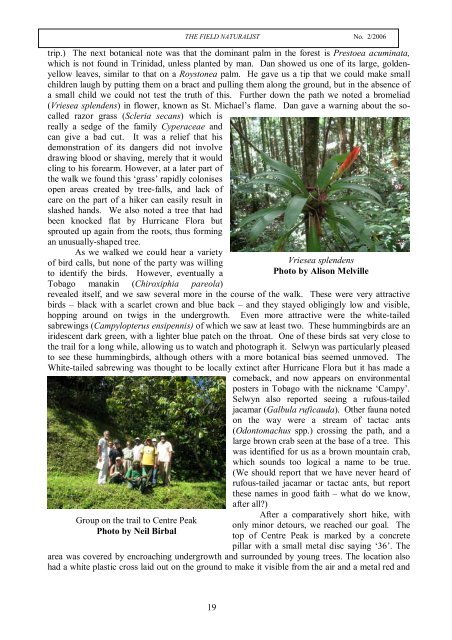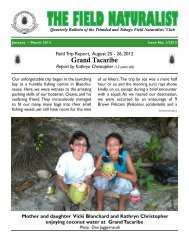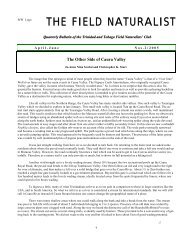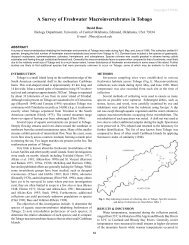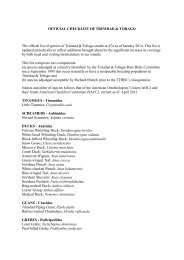Vol 2 - The Trinidad and Tobago Field Naturalists' Club
Vol 2 - The Trinidad and Tobago Field Naturalists' Club
Vol 2 - The Trinidad and Tobago Field Naturalists' Club
Create successful ePaper yourself
Turn your PDF publications into a flip-book with our unique Google optimized e-Paper software.
THE FIELD NATURALIST No. 2/2006trip.) <strong>The</strong> next botanical note was that the dominant palm in the forest is Prestoea acuminata,which is not found in <strong>Trinidad</strong>, unless planted by man. Dan showed us one of its large, goldenyellowleaves, similar to that on a Roystonea palm. He gave us a tip that we could make smallchildren laugh by putting them on a bract <strong>and</strong> pulling them along the ground, but in the absence ofa small child we could not test the truth of this. Further down the path we noted a bromeliad(Vriesea splendens) in flower, known as St. Michael’s flame. Dan gave a warning about the socalledrazor grass (Scleria secans) which isreally a sedge of the family Cyperaceae <strong>and</strong>can give a bad cut. It was a relief that hisdemonstration of its dangers did not involvedrawing blood or shaving, merely that it wouldcling to his forearm. However, at a later part ofthe walk we found this ‘grass’ rapidly colonisesopen areas created by tree-falls, <strong>and</strong> lack ofcare on the part of a hiker can easily result inslashed h<strong>and</strong>s. We also noted a tree that hadbeen knocked flat by Hurricane Flora butsprouted up again from the roots, thus formingan unusually-shaped tree.As we walked we could hear a varietyof bird calls, but none of the party was willingto identify the birds. However, eventually a<strong>Tobago</strong> manakin (Chiroxiphia pareola)Group on the trail to Centre PeakPhoto by Neil BirbalVriesea splendensPhoto by Alison Melvillerevealed itself, <strong>and</strong> we saw several more in the course of the walk. <strong>The</strong>se were very attractivebirds – black with a scarlet crown <strong>and</strong> blue back – <strong>and</strong> they stayed obligingly low <strong>and</strong> visible,hopping around on twigs in the undergrowth. Even more attractive were the white-tailedsabrewings (Campylopterus ensipennis) of which we saw at least two. <strong>The</strong>se hummingbirds are aniridescent dark green, with a lighter blue patch on the throat. One of these birds sat very close tothe trail for a long while, allowing us to watch <strong>and</strong> photograph it. Selwyn was particularly pleasedto see these hummingbirds, although others with a more botanical bias seemed unmoved. <strong>The</strong>White-tailed sabrewing was thought to be locally extinct after Hurricane Flora but it has made acomeback, <strong>and</strong> now appears on environmentalposters in <strong>Tobago</strong> with the nickname ‘Campy’.Selwyn also reported seeing a rufous-tailedjacamar (Galbula ruficauda). Other fauna notedon the way were a stream of tactac ants(Odontomachus spp.) crossing the path, <strong>and</strong> alarge brown crab seen at the base of a tree. Thiswas identified for us as a brown mountain crab,which sounds too logical a name to be true.(We should report that we have never heard ofrufous-tailed jacamar or tactac ants, but reportthese names in good faith – what do we know,after all?)After a comparatively short hike, withonly minor detours, we reached our goal. <strong>The</strong>top of Centre Peak is marked by a concretepillar with a small metal disc saying ‘36’. <strong>The</strong>area was covered by encroaching undergrowth <strong>and</strong> surrounded by young trees. <strong>The</strong> location alsohad a white plastic cross laid out on the ground to make it visible from the air <strong>and</strong> a metal red <strong>and</strong>19


